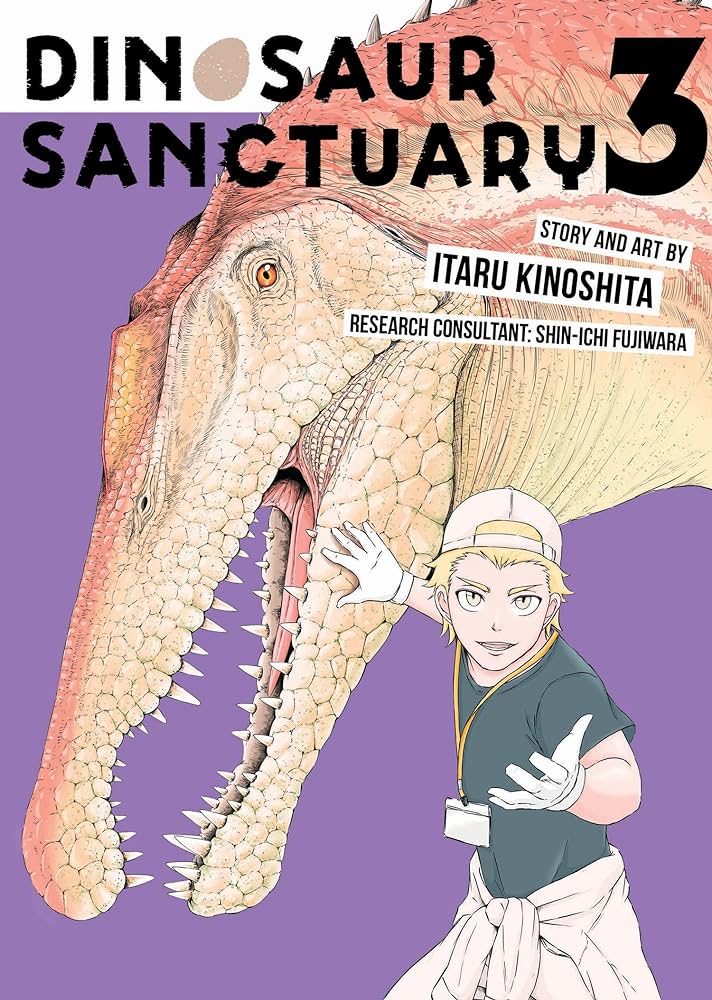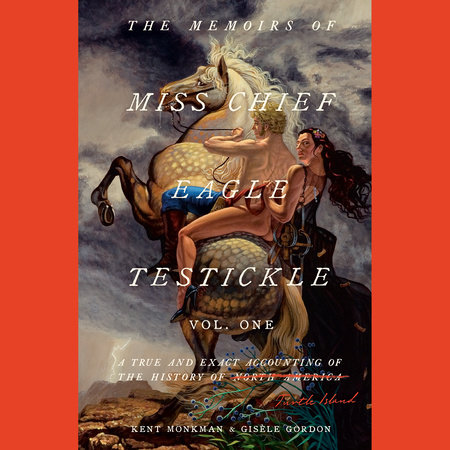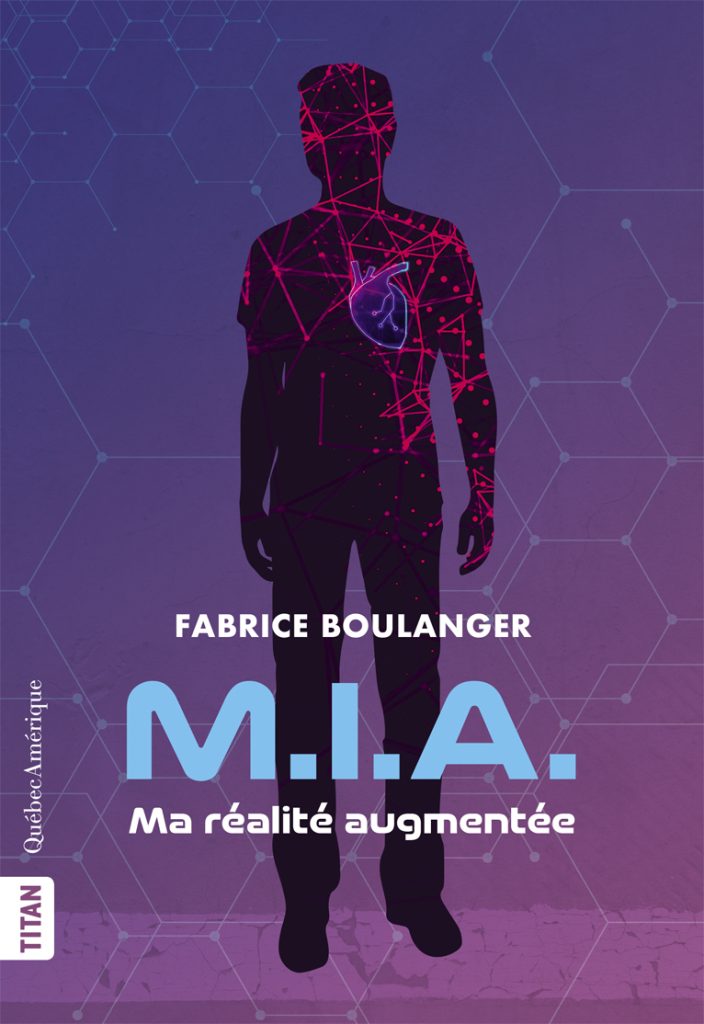Dinosaur Sanctuary 3
By Magdalena Nitchi

Over this past year, Itaru Kinoshita’s Dinosaur Sanctuary has quickly become my favourite manga. In the third and latest volume, Suma Suzume has completed her training and is now spending time with each of the department heads in order to figure out which park area suits her best, starting with head keeper of the herbivores, Igarashi Keisuke.
Since its beginning, Dinosaur Sanctuary has consistently provided the perfect blend of science and fun. Kinoshita continues to characterize the new dinosaurs in ways that fit their species perfectly, while still creating a distinct personality for each one. Each one poses a unique challenge for Suzume, from figuring out why Haichibei the pachycephalosaurus is ill, to convincing Momiji the stegosaurus to allow herself to be transported to a new enclosure. Igarashi’s backstory of working at a marine-life amusement park offers a fascinating glimpse into other theme parks from this alternate universe, and shows that Suzume’s drive to educate and engage with the public is particularly well suited to the mission of Enoshima Dinoland.
However, the story that charmed me the most was unrelated to the main plot. In chapter 15, “Dinosaur Fans Forever!”, readers are introduced to Akiho and Yukari, two childhood dinosaur fans who bonded over frequent visits to Dinoland and their special love for Eiger the spinosaurus. But when Yukari does not defend Akiho after facing social pressure due to her childish love of dinosaurs, a wedge is driven between the two friends. I admire Kinoshita’s ability to make a moving story out of classic tropes, create characters which feel real in the span of only a few pages, and to develop the world outside Dinoland while retaining focus on the park.
Dinosaur Sanctuary 3, with its incredibly sweet story, genuinely informative paleontology lessons, and lovable characters is a perfect holiday read. As the English translation of the fourth volume is only set to release in March, there is still plenty of time to catch up on the entire series, which is definitely what I recommend for readers looking to fully enjoy this volume. While each volume stands on its own, a wider story arc is building up, and I can’t wait to see where the talented team of Kinoshita and scientific consultant Fujiwara will take readers next!
The Memoirs of Miss Chief Eagle Testickle: A True and Exact Accounting of the History of Turtle Island Vol. 1
By Olivia Shan

With a towering twenty-year long career that’s seen him lauded nationally and abroad, Cree painter Kent Monkman is undeniably one of the most important artists working today. This past month, Monkman and his longtime collaborator Gisèle Gordon presented their ambitious literary debut: The Memoirs of Miss Chief Eagle Testickle: A True and Exact Accounting of the History of Turtle Island— which, in this critic’s opinion, is a defining chef d’oeuvre in the last decade of Canadian publishing.
Given that Monkman and Gordon’s artwork often defies labels and plays with genre conventions, it’s unsurprising that their first book is also unconventional in almost every way. Complete in two beautifully produced volumes published within the span of a month, these fictionalised “memoirs” can only be described as a delightfully queer blend of a great many eclectic genres: the artbook, history book, memoir, satire, fantasy, and mythological creation story.
Miss Chief Eagle Testickle, for those not familiar, is a shape-shifting, time-traveling, supernatural character, who represents a genderqueer alter ego of Monkman himself. As the title suggests, the Memoirs present a vision of history that is both intimate and vast— and purportedly, more “truthful” than what any version we’ve previously been taught. Whereas Miss Chief previously only served as a recurring figure in Monkman’s artwork, her role as an agent that reverses the colonial gaze is now gracefully transposed into the realms of literature and historical writing.
Thanks to these impressively detailed and intricate stories, Monkman and Gordon have allowed Miss Chief’s animated narrative voice to become crystallised into the imaginarium of Turtle Island as we know it. The result is a delightful, funny, moving, and whimsical piece of mythos.
Though Miss Chief’s Memoirs are a self-proclaimed “imagined history,” their message is genuine and clear: there will never be a truly accurate version of what we claim to be “history” without a serious reconsidering of Indigenous perspectives as active and important contributors to all of our grand narratives.
M. I. A. : Ma réalité augmentée
Par Magdalena Nitchi

Bien que j’aie déjà dépassé l’âge de la littérature « jeunesse », je prends toujours autant plaisir à m’y plonger de temps à autre. Récemment, j’ai fait la découverte de M. I. A. : Ma réalité augmentée de Fabrice Boulanger. L’idée d’observer comment l’intelligence artificielle serait abordée pour un public aussi jeune a suscité ma curiosité. Paru en 2022, l’œuvre de Boulanger s’appuie sur les récentes percées technologiques, plus particulièrement celles utilisées pour aider les personnes en situation de handicap. C’est une création à la fois divertissante et légère.
Dans une histoire aux accents de superhéros, Damien, un élève de neuvième année (sec. 3), se retrouve tétraplégique à la suite d’un tragique accident. Cependant, son père, spécialiste en IA, parvient à persuader sa femme de laisser Damien participer à une expérience novatrice. Après plusieurs mois de coma, Damien se réveille avec un nouvel ensemble de membres prothétiques intégrés sous sa peau, assisté par une IA remplaçant sa colonne vertébrale endommagée.
Pourtant, Damien n’a pas un contrôle total ; il ne peut ni ressentir ni bouger son corps à sa propre guise. Il doit plutôt apprendre à diriger l’IA afin de concrétiser ses intentions. Bien que certains clichés subsistent, comme celui dont le protagoniste préférerait la mort au handicap, l’histoire présente en dépit de cela une perspective intéressante de l’adaptation à la vie avec des nouvelles technologies d’accessibilité.
Un bon nombre de passages sont clairement axé pour un.e lecteur.ice plus jeune – comme les conflits avec son père ou sa rivalité avec le chum de son béguin –mais la sincérité de Damien demeure malgré tout charmante. J’ai été particulièrement intriguée par l’idée d’une IA qui apprend les émotions ressenties par une personne au moyen d’un lien direct avec le cerveau de cette dernière, car elle a toujours de la difficulté à comprendre les émotions humaines.
Si vous voulez introduire un.e jeune lecteur.ice à l’univers de la science-fiction, voilà un bon livre contemporain pour commencer. Boulanger explore les notions du contrôle et de la dépendance humaine à l’égard des machines sans en faire un cauchemar dystopique. M. I. A. incitera tout enfant à explorer davantage d’histoires sur l’IA.
